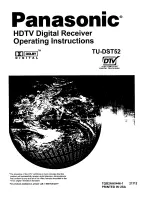
4
FMA limited warranty for receivers
FMA, Inc. warrants this product to be free of manufacturing defects for the term of one year from the date of
purchase. Should any defects covered by this warranty occur, the product shall be repaired or replaced with a
unit of equal performance by FMA or an authorized FMA service station.
Limits and exclusions
This warranty may be enforced only by the original purchaser, who uses this product in its original condition as
purchased, in strict accordance with the product’s instructions. Units returned for warranty service to an FMA
service center will be accepted for service when shipped postpaid, with a copy of the original sales receipt or
warranty registration form, to the service station designated by FMA.
This warranty does not apply to:
Consequential or incidental losses resulting from the use of this product.
Damage resulting from accident, misuse, abuse, neglect, electrical surges, reversed polarity on connectors,
lightning or other acts of God.
Damage from failure to follow instructions supplied with the product.
Damage occurring during shipment of the product either to the customer or from the customer for service
(claims must be presented to the carrier).
Damage resulting from repair, adjustment, or any alteration of the product by anyone other than an authorized
FMA technician.
Installation or removal charges, or damage caused by improper installation or removal.
Call (301) 668-7614 for more information about service and warranty repairs.
FS Receiver button summary
Button functions in Setup Mode
Do this...
And this happens...
Press and hold button, turn on receiver
Receiver enters Setup Mode (LED “twinkles”).
Servos set for Last Frame Mode move slowly,
servos set for Failsafe Mode move to failsafe
positions (and don't move after that).
Move transmitter stick(s) to servo failsafe position
for channel(s), press button, return transmitter
stick(s) to neutral (or low for throttle)
Receiver sets servo to failsafe position(s) for
channel(s).
For mixed channels, this sets
failsafe positions for all channels in mix.
Press and hold button for 2 seconds
Receiver sets all channels to Last Frame Hold
Mode (this erases Failsafe Mode servo presets
on all channels).
Button functions in Normal Flight Mode
Do this...
And this happens...
Don’t press button
LED blinks number of failsafes (up to 9) since receiver was turned on. No
blinks = perfect signal.
Press button 1 time
LED blinks battery voltage (each long blink = 1V, each short blink = 0.1V).
Press button 3 times
LED blinks number of bad frames (up to 99) since receiver was turned on
(each long blink = 10 bad frames, each short blink = 1 bad frame). (Less
than 30 bad frames indicates very clean signal during typical flight.)
Press button 5 times
Change between 1X and 2X LED blink rate
(1X = 1 blink/second, 2X = 2 blinks/second).
Tip:
When checking for bad frames or changing blink rate, make each press before LED turns on.
FMA, Inc. 5716A Industry Lane Frederick, MD 21704
Sales: (800) 343-2934 Technical: (301) 668-7614 www.fmadirect.com
Flight System
FS5 Receiver for Aircraft
Features
Protect your investment before you take off, while you’re flying, and after you land.
Universal operation: works with negative shift (Futaba, Hitec) and positive shift (JR, Airtron-
ics) PPM transmitters. For aircraft (72MHz) installations.
Full range, full performance. Can be used in aircraft ranging from park flyers to IMAA-legal
aircraft to helicopters.
Interference check tells you if it’s safe to fly. Detects both on- and off-channel interference.
Digital Signal Recognition eliminates nearly all interference.
Better range checking: receiver records signal loss (if any) during check, then displays result.
Set any channel for a failsafe position using your transmitter. On loss of signal, failsafe chan-
nels move to preset positions, other channels hold last good frame position.
LED blinks battery voltage, number of failsafes and number of bad frames received.
Viewer Software provides real-time display and analysis of receiver operation and setup.
Note:
This manual provides basic instructions. More informa-
tion is available to help you use the receiver:
Online help file for FS Receiver Viewer Software.
FS Receiver and Viewer Software manual in PDF (download
from the Support section at www.fmadirect.com).
Safety precautions
Follow all instructions in this manual to assure safe operation.
If you have not assembled and operated a radio controlled model before, obtain help from an
experienced modeler. You will need guidance to successfully assemble, test and operate radio
controlled models. One of the best ways to obtain help is to join your local radio control club.
In some areas of the country, you cannot legally operate radio controlled models except at
approved fields. Check with local authorities first.
Observe frequency control. If someone else is operating a radio controlled model on the same
channel as your transmitter,
do not turn on your transmitter—even for a short time.
Your
transmitter has a channel number marked somewhere on its case.
When a model receives
signals from two transmitters on the same channel at the same time, it cannot be con-
trolled and will crash—possibly causing personal injury or property damage.
For safety,
most RC flying fields have formal frequency control rules. Follow them carefully.
Do not operate your radio control transmitter within 3 miles of a flying field. Even at a dis-
tance, your transmitter can cause interference.
Parts list
FS Receiver.
Viewer Software CD (see
separate instructions; not
required for setting up and
operating the receiver).
You must supply:
Crystal: FMA Quantum or Fortress series dual conversion or
Hitec dual conversion (on same channel as your transmitter).
Battery pack: typically 4 or 5 cell NiCd. (Do not use alkaline
batteries!)
Radio on/off switch harness.
Servos.
User Guide Version 1.29 Rev 1




















